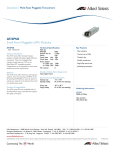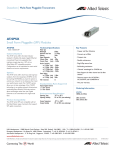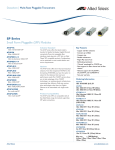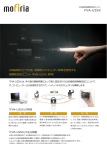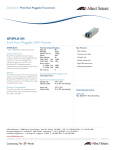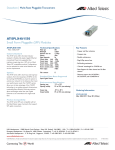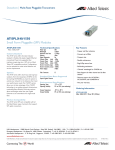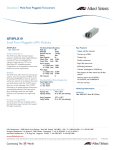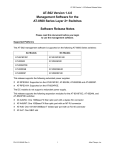Download Allied Telesis AT-CV1KSS Installation guide
Transcript
AT-SPSX SFP Transceiver Installation Guide AT-SPSX SFP Transceiver Installation Guide AT-SPSX SFP Transceiver Installation Guide AT-SPSX SFP Transceiver Installation Guide Overview Overview Overview Overview The AT-SPSX SFP transceiver is capable of reaching a maximum operating distance of up to 500 m and transmits using an 850 nm wavelength. The AT-SPSX SFP transceiver is capable of reaching a maximum operating distance of up to 500 m and transmits using an 850 nm wavelength. The AT-SPSX SFP transceiver is capable of reaching a maximum operating distance of up to 500 m and transmits using an 850 nm wavelength. The AT-SPSX SFP transceiver is capable of reaching a maximum operating distance of up to 500 m and transmits using an 850 nm wavelength. The AT-SPSX SFP transceiver is designed to be used in ATI products such as the AT-8000 and AT-9400 series switches. The AT-SPSX SFP transceiver is designed to be used in ATI products such as the AT-8000 and AT-9400 series switches. The AT-SPSX SFP transceiver is designed to be used in ATI products such as the AT-8000 and AT-9400 series switches. The AT-SPSX SFP transceiver is designed to be used in ATI products such as the AT-8000 and AT-9400 series switches. Verifying Package Contents Verifying Package Contents Verifying Package Contents Verifying Package Contents Make sure that the correct component and installation instructions are included in your package. If any item is missing or damaged, contact your Allied Telesyn sales representative for assistance. Make sure that the correct component and installation instructions are included in your package. If any item is missing or damaged, contact your Allied Telesyn sales representative for assistance. Make sure that the correct component and installation instructions are included in your package. If any item is missing or damaged, contact your Allied Telesyn sales representative for assistance. Make sure that the correct component and installation instructions are included in your package. If any item is missing or damaged, contact your Allied Telesyn sales representative for assistance. AT-SPSX Specifications AT-SPSX Specifications AT-SPSX Specifications AT-SPSX Specifications Model AT-SPSX Maximum Distance Type of Fiber Optic Cable 500 m 50/125 µm multimode fiber 300 m 62.5/125 µm multimode fiber The SFP transceiver uses a fiber optic cable with LC connectors. Model AT-SPSX Maximum Distance Type of Fiber Optic Cable 500 m 50/125 µm multimode fiber 300 m 62.5/125 µm multimode fiber The SFP transceiver uses a fiber optic cable with LC connectors. Model AT-SPSX Maximum Distance Type of Fiber Optic Cable 500 m 50/125 µm multimode fiber 300 m 62.5/125 µm multimode fiber The SFP transceiver uses a fiber optic cable with LC connectors. Model AT-SPSX Maximum Distance Type of Fiber Optic Cable 500 m 50/125 µm multimode fiber 300 m 62.5/125 µm multimode fiber The SFP transceiver uses a fiber optic cable with LC connectors. Laser Class 1 laser product. Do not stare into the laser beam. Laser Class 1 laser product. Do not stare into the laser beam. Laser Class 1 laser product. Do not stare into the laser beam. Laser Class 1 laser product. Do not stare into the laser beam. Note A transceiver must be connected to another transceiver or fiber optic port that has similar operating characteristics. Note A transceiver must be connected to another transceiver or fiber optic port that has similar operating characteristics. Note A transceiver must be connected to another transceiver or fiber optic port that has similar operating characteristics. Note A transceiver must be connected to another transceiver or fiber optic port that has similar operating characteristics. Note You can hot swap the SFP transceiver. You do not need to power off the networking device when you install or replace an SFP transceiver. Note You can hot swap the SFP transceiver. You do not need to power off the networking device when you install or replace an SFP transceiver. Note You can hot swap the SFP transceiver. You do not need to power off the networking device when you install or replace an SFP transceiver. Note You can hot swap the SFP transceiver. You do not need to power off the networking device when you install or replace an SFP transceiver. Installing an AT-SPSX SFP Transceiver Installing an AT-SPSX SFP Transceiver Installing an AT-SPSX SFP Transceiver Installing an AT-SPSX SFP Transceiver To install an AT-SPSX transceiver, perform the following procedure: To install an AT-SPSX transceiver, perform the following procedure: To install an AT-SPSX transceiver, perform the following procedure: To install an AT-SPSX transceiver, perform the following procedure: Caution The transceiver can be damaged by static electricity. Be sure to observe all standard electrostatic discharge (ESD) precautions, such as wearing an antistatic wrist strap, to avoid damaging the device. Caution The transceiver can be damaged by static electricity. Be sure to observe all standard electrostatic discharge (ESD) precautions, such as wearing an antistatic wrist strap, to avoid damaging the device. Caution The transceiver can be damaged by static electricity. Be sure to observe all standard electrostatic discharge (ESD) precautions, such as wearing an antistatic wrist strap, to avoid damaging the device. Caution The transceiver can be damaged by static electricity. Be sure to observe all standard electrostatic discharge (ESD) precautions, such as wearing an antistatic wrist strap, to avoid damaging the device. 1. Remove the transceiver from the shipping package and store the packaging material in a safe place. 1. Remove the transceiver from the shipping package and store the packaging material in a safe place. 1. Remove the transceiver from the shipping package and store the packaging material in a safe place. 1. Remove the transceiver from the shipping package and store the packaging material in a safe place. 2. Slide the transceiver into the SFP slot. 2. Slide the transceiver into the SFP slot. 2. Slide the transceiver into the SFP slot. 2. Slide the transceiver into the SFP slot. If you are connecting the fiber optic cable to the SFP at this time, continue to step 3. Otherwise, stop here. If you are connecting the fiber optic cable to the SFP at this time, continue to step 3. Otherwise, stop here. If you are connecting the fiber optic cable to the SFP at this time, continue to step 3. Otherwise, stop here. If you are connecting the fiber optic cable to the SFP at this time, continue to step 3. Otherwise, stop here. 3. Remove the dust cover. 3. Remove the dust cover. 3. Remove the dust cover. 3. Remove the dust cover. 4. Connect the fiber optic cable to the transceiver. 4. Connect the fiber optic cable to the transceiver. 4. Connect the fiber optic cable to the transceiver. 4. Connect the fiber optic cable to the transceiver. For information about the transceiver port LEDs, refer to the appropriate hardware installation guide. For information about the transceiver port LEDs, refer to the appropriate hardware installation guide. For information about the transceiver port LEDs, refer to the appropriate hardware installation guide. For information about the transceiver port LEDs, refer to the appropriate hardware installation guide. Electrical Safety and Emission Statement Electrical Safety and Emission Statement Electrical Safety and Emission Statement Electrical Safety and Emission Statement Standards: This product meets the following standards. Standards: This product meets the following standards. Standards: This product meets the following standards. Standards: This product meets the following standards. U.S. Federal Communications Commission U.S. Federal Communications Commission U.S. Federal Communications Commission U.S. Federal Communications Commission Radiated Energy Note: This equipment has been tested and found to comply with the limits for a Class A digital device pursuant to Part 15 of FCC Rules. These limits are designed to provide reasonable protection against harmful interference when the equipment is operated in a commercial environment. This equipment generates, uses, and can radiate radio frequency energy and, if not installed and used in accordance with this instruction manual, may cause harmful interference to radio communications. Operation of this equipment in a residential area is likely to cause harmful interference in which case the user will be required to correct the interference at his own expense. Note: Modifications or changes not expressly approved of by the manufacturer or the FCC, can void your right to operate this equipment. Radiated Energy Note: This equipment has been tested and found to comply with the limits for a Class A digital device pursuant to Part 15 of FCC Rules. These limits are designed to provide reasonable protection against harmful interference when the equipment is operated in a commercial environment. This equipment generates, uses, and can radiate radio frequency energy and, if not installed and used in accordance with this instruction manual, may cause harmful interference to radio communications. Operation of this equipment in a residential area is likely to cause harmful interference in which case the user will be required to correct the interference at his own expense. Note: Modifications or changes not expressly approved of by the manufacturer or the FCC, can void your right to operate this equipment. Radiated Energy Note: This equipment has been tested and found to comply with the limits for a Class A digital device pursuant to Part 15 of FCC Rules. These limits are designed to provide reasonable protection against harmful interference when the equipment is operated in a commercial environment. This equipment generates, uses, and can radiate radio frequency energy and, if not installed and used in accordance with this instruction manual, may cause harmful interference to radio communications. Operation of this equipment in a residential area is likely to cause harmful interference in which case the user will be required to correct the interference at his own expense. Note: Modifications or changes not expressly approved of by the manufacturer or the FCC, can void your right to operate this equipment. Radiated Energy Note: This equipment has been tested and found to comply with the limits for a Class A digital device pursuant to Part 15 of FCC Rules. These limits are designed to provide reasonable protection against harmful interference when the equipment is operated in a commercial environment. This equipment generates, uses, and can radiate radio frequency energy and, if not installed and used in accordance with this instruction manual, may cause harmful interference to radio communications. Operation of this equipment in a residential area is likely to cause harmful interference in which case the user will be required to correct the interference at his own expense. Note: Modifications or changes not expressly approved of by the manufacturer or the FCC, can void your right to operate this equipment. Industry Canada Industry Canada Industry Canada Industry Canada This Class A digital apparatus meets all requirements of the Canadian Interference-Causing Equipment Regulations. Cet appareil numérique de la classe A respecte toutes les exigences du Règlement sur le matériel brouilleur du Canada. This Class A digital apparatus meets all requirements of the Canadian Interference-Causing Equipment Regulations. Cet appareil numérique de la classe A respecte toutes les exigences du Règlement sur le matériel brouilleur du Canada. This Class A digital apparatus meets all requirements of the Canadian Interference-Causing Equipment Regulations. Cet appareil numérique de la classe A respecte toutes les exigences du Règlement sur le matériel brouilleur du Canada. This Class A digital apparatus meets all requirements of the Canadian Interference-Causing Equipment Regulations. Cet appareil numérique de la classe A respecte toutes les exigences du Règlement sur le matériel brouilleur du Canada. RFI Emission: EN55022 Class A RFI Emission: EN55022 Class A RFI Emission: EN55022 Class A RFI Emission: EN55022 Class A Warning: In a domestic environment this product may cause radio interference in which case the user may be required to take adequate measures. Warning: In a domestic environment this product may cause radio interference in which case the user may be required to take adequate measures. Warning: In a domestic environment this product may cause radio interference in which case the user may be required to take adequate measures. Warning: In a domestic environment this product may cause radio interference in which case the user may be required to take adequate measures. Immunity: EN55024 Immunity: EN55024 Immunity: EN55024 Immunity: EN55024 Electrical Safety: EN60950, EN60825, UL1950 (CULUS) Electrical Safety: EN60950, EN60825, UL1950 (CULUS) Electrical Safety: EN60950, EN60825, UL1950 (CULUS) Electrical Safety: EN60950, EN60825, UL1950 (CULUS) Copyright © 2004 Allied Telesyn, Inc. All rights reserved. No part of this publication may be reproduced without prior written permission from Allied Telesyn, Inc. Copyright © 2004 Allied Telesyn, Inc. All rights reserved. No part of this publication may be reproduced without prior written permission from Allied Telesyn, Inc. PN 613-50608-00 Rev B | PN 613-50608-00 Rev B Copyright © 2004 Allied Telesyn., Inc. All rights reserved. No part of this publication may be reproduced without prior written permission from Allied Telesyn, Inc. | PN 613-50608-00 Rev B Copyright © 2004 Allied Telesyn, Inc. All rights reserved. No part of this publication may be reproduced without prior written permission from Allied Telesyn, Inc. | PN 613-50608-00 Rev B


